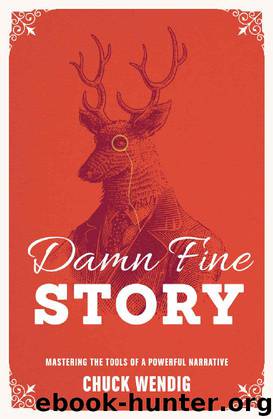Damn Fine Story: Mastering the Tools of a Powerful Narrative by Chuck Wendig

Author:Chuck Wendig [Wendig, Chuck]
Language: eng
Format: epub
Publisher: F+W Media
Published: 2017-10-17T04:00:00+00:00
THE MYSTERIOUS MISTS OF MYSTERY: OR, THE POWER OF QUESTION-DRIVEN PLOTTING
To repeat: Questions are the food that feeds the audience. Or, to be more precise: Answers feed the audience, and questions keep them hungry. And boy, howdy, do we want them hungry! We want them hungry enough that they keep coming back for another nibble—but we don’t want them so mad with hunger that they put the book down or turn the show off. Storytelling is an act of delivering satisfaction in the most meager doses possible. It’s a tightrope act—you don’t want them overfed, you don’t want them underfed. Always hungry, never starving.
Now, plotting a story—whether you outline it on paper or inside your own skull cave—is the act of moving the story forward, step by step and scene by scene. It is, loosely, the act of determining the sequence of events as it is revealed to the audience. Not just what happens when, but the arrangement of those events and how the revelations stack up. An outline becomes this is revealed, then that, then this other thing, now the end.
The problem is that, when we approach it this way, we run the risk of a disconnected, external plot taking over the narrative. Plot ends up being this giant, Godzilla-shaped, kaiju thing, grumpily staggering through the cityscape of your characters, stepping on everything and knocking shit down and carving its own cataclysmic swath through the careful architecture and urban planning you’ve created. We don’t want that. We don’t want event-driven plotting. We want character-driven plotting, where the agency of an individual character pushes and pulls against the agency of all the other characters. Then the story that’s told is not so much a clean line as it is a web—tug here, feel it there—a constant balancing and rebalancing.
How do we get there? How can we plot and scheme that out? How do we take a ground-level, organic approach to plotting?
First we take LSD and wander naked into the jungle to find and fight the Jaguar King and then from there—
Wait, whoa, that’s not right at all. I’m so sorry.24
No. What I mean to say is that we begin with questions.
Two kinds of overarching questions drive a story:
The questions that drive the characters.
The questions that drive the audience.
Download
This site does not store any files on its server. We only index and link to content provided by other sites. Please contact the content providers to delete copyright contents if any and email us, we'll remove relevant links or contents immediately.
Asking the Right Questions: A Guide to Critical Thinking by M. Neil Browne & Stuart M. Keeley(5369)
Autoboyography by Christina Lauren(5099)
Eat That Frog! by Brian Tracy(4170)
Dialogue by Robert McKee(4167)
Sticky Fingers by Joe Hagan(3916)
Journeys Out of the Body by Robert Monroe(3468)
Annapurna by Maurice Herzog(3305)
Full Circle by Michael Palin(3278)
Elements of Style 2017 by Richard De A'Morelli(3239)
Schaum's Quick Guide to Writing Great Short Stories by Margaret Lucke(3201)
The Art of Dramatic Writing: Its Basis in the Creative Interpretation of Human Motives by Egri Lajos(2865)
The Diviners by Libba Bray(2804)
Why I Write by George Orwell(2783)
The Mental Game of Writing: How to Overcome Obstacles, Stay Creative and Productive, and Free Your Mind for Success by James Scott Bell(2772)
In Patagonia by Bruce Chatwin(2766)
The Fight by Norman Mailer(2712)
Atlas Obscura by Joshua Foer(2708)
Venice by Jan Morris(2441)
The Elements of Style by William Strunk and E. B. White(2379)
